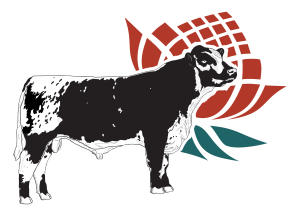SPECKLE PARK HISTORY
The daughter of a cattle farmer in Northern Sasketchewan, Canada, Mary Lindsay had always admired unique coloured livestock. She took a particular interest in cattle, so when in late 1937 the markings of a speckled red roan heifer caught her eye amongst her father’s herd, she took the liberty of purchasing it from her father. Thus began the long journey of developing what is now known as the Speckle Park into a recognised pure breed, the first to come out of Sasketchewan, Canada.
The unique speckled markings seemed to be a dominant trait as no matter what breed of sire she bred with her speckled red roan, the result would always be the same, producing a calf with the same coloured pattern. Mary’s cattle were quiet natured and are believed to be the descendants of a Teeswater Shorthorn, known for their strength and hardy characteristics. This breed of cattle dated back to the 16th century and along with the Red Roan, carried the White Park gene. Thanks to the traits passed on by their ancestors, Mary’s cattle were quiet natured, hardy and grew quickly.
A couple by the name of Bill and Eileen Lamont of Maidstone, SK took an interest in Mary’s speckled cattle as they thought they would go well with their speckled horses and black cows. They purchased their first speckled heifer from Mary in 1959. By the early 1960’s Bill and Eileen crossed their speckled cows with quality black Angus bulls, producing a number of offspring of various colour patterns. These included white with black points, leopard coloured (spotted on their side) and black sided with speckled hips, white top and underline roan faces. Their continued hard work in breeding high quality carcass cattle meant that their speckled cattle had light birth weights. At this point the speckled breed was named Speckle Park. Other cattle farmers showed great interest when they saw they were bringing a premium price in the cattle markets and hence started buying bulls and females. A group of dedicated breeders started breeding these cattle in only a few years. With the assistance from a number of other cattlemen in Saskatchewan, the Lamonts formed the Canadian Speckle Park Association in 1985. It was their objective to stabilize the breed and eventually have them recognised as a pure cattle breed.
A step in the right direction occurred on 4 June 1993 when Speckle Park were declared an evolving breed by Agriculture Canada and on 14 February 1995 the associations first set of by-laws was granted ministerial approval. In order to start a new breed in Canada, it must go through stringent protocol procedures in order to have it declared a ‘Distinct Breed’ and only occurs once the breed has held the status of ‘Evolving Breed’. This is all overseen by Government Authorities. Finally on 6 July 2006, the Speckle Park Breed was announced a pure breed by the Minister for Agriculture.
Today, on the Canadian register there are 70 members and 3000 registered cows. Exports increased during 2007 and 2008 with over 700 embryos and 1500 straws of Speckle Park genetics were exported to New Zealand, Ireland, Australia and Denmark.
In 2007, a group of Australians formed the Australian Speckle Park Association and will be responsible for registrations in both Australia and New Zealand. They will be the first to have a Performance Data Recording System in place for Speckle Parks, with the University of New England in Armidale, Australia and the Agricultural Business Research Institute of Australia, which will bring a new and exciting dimension to the breed. Today there are well over 5000 embryos imported into Australia.
